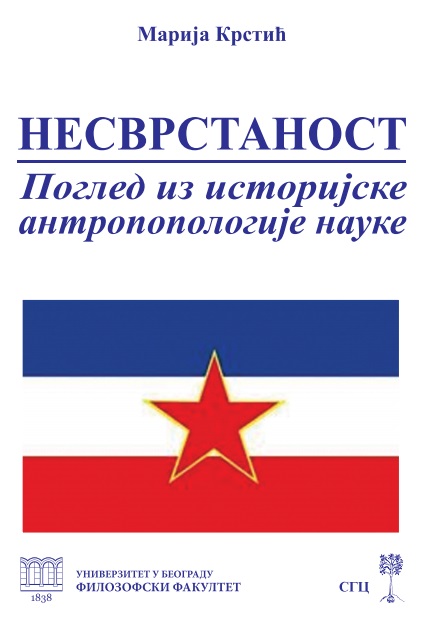
We kindly inform you that, as long as the subject affiliation of our 300.000+ articles is in progress, you might get unsufficient or no results on your third level or second level search. In this case, please broaden your search criteria.

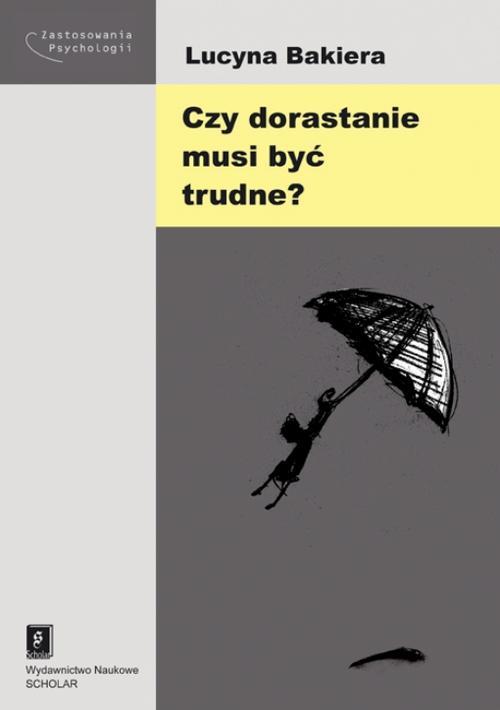
Niewątpliwymi atutami książki są z jednej strony rzetelna informacja o zmianach zachodzących w życiu młodych ludzi – podana w sposób logiczny i uporządkowany, z drugiej zaś – spojrzenie poradnikowe: jak dorośli mogą na te zmiany reagować i które reakcje pomagają, a które przeszkadzają w rozwoju i układaniu wzajemnych relacji. Autorka pokazuje trudności, ale przedstawia je jako normalne i rozwojowe, wyjaśnia, obala mity. Pisze w sposób wyważony, nie posługuje się stereotypami, nie straszy, lecz uspokaja, buduje zrozumienie, co nadaje całości konstruktywny, pozytywny wydźwięk. Praca łączy w sobie wysokie walory merytoryczne dobrej książki naukowej z przystępnością formy i lekkością pióra książki popularnej. Co więcej, zawiera jasne i cenne wskazówki dotyczące postępowania. To połączenie wiedzy, mądrości i dobrego stylu czyni z niej pozycję ze wszech miar wartą polecenia. /// Z recenzji prof. dr. hab. Piotra K. Olesia
More...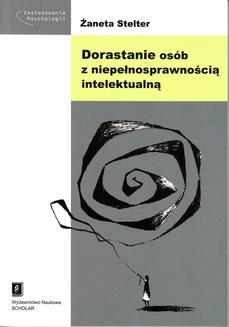
Autorka przedstawia problemy związane z dojrzewaniem dziewcząt i chłopców niepełnosprawnych intelektualnie. Omawia zmiany biologiczne, intelektualne, emocjonalne i społeczne pojawiające się w okresie dojrzewania, wyraziście ukazując spiętrzenie trudności w przypadku tej grupy młodzieży. Ukazuje specyfikę dorastania dziewcząt i chłopców, którzy zmagają się z trudnościami wynikającymi nie tylko z ich możliwości umysłowych, ale nierzadko również z tego, jak są odbierani przez społeczeństwo. Zwraca uwagę na negatywne zjawiska społeczne, takie jak stygmatyzacja, piętnowanie czy wykluczenie. Obok problemów dotykających samych niepełnosprawnych Autorka stara się przybliżyć Czytelnikowi również trudności ich najbliższych, którzy stają przed trudnym zadaniem opieki i wychowywania dziecka upośledzonego umysłowo. Żaneta Stelter obala także mity dotyczące zachowania niepełnosprawnych, m.in. mit „wiecznego dziecka” i mit „bezczynności”.
More...
The book is devoted to the phenomenon of persuasiveness in television public service advertisements. The said type of advertisements is aimed at prompting particular socially desirable attitudes or persuading members of the audience to cease their socially undesirable behaviour. Therefore, such campaigns serve to transform currently existing reality and disseminate knowledge related to social phenomena and to engage audience in social matters.The monograph is composed of seven chapters, complemented with introduction and summarising section, along with an extensive bibliography, and the lists of tables and figures appearing therein. First four chapters, written on the basis of rich literature on the subject in question, are of theoretical character. In a form of an outline, they present the history of advertising and its defining features, fundamental issues involving contemporary advertisements and their role in shaping public opinion; but also important questions falling into the scope of public service marketing, its origin, devices, and functions performed by it. Another discussed issue are the methods of exerting influence by mean of a message contained in an advertisement, which are synonymous with persuasion and targeted at changing the members of the audience’s attitudes. The chapter concluding this part of the publication deals with persuasion in public service advertisements directly. Polish public service advertisements, characterised according to their problematic, are presented in the said chapter, along with the discussion of the means of persuasion used in them, particularly: the formal concept, auditory, verbal and visual layers, and a type of protagonists featured.Part two of the book, which is empirically oriented, presents the author’s own research relating to the public service advertisements broadcasted in Poland in the years 2005–2010. The proper research sample (n = 99) was obtained on the basis of the probabilistic random sampling method. The formulated research problem is the role of public service advertisements in the process of shaping social awareness as well as the members of the audience’s attitudes. What was set as the research aim, was the analysis of particular advertisements’ contents and the comparative analysis thereof. Chapter five discusses the research method used (content analysis), the technique devised by the author (categorization key), and the implemented methods of analysis and interpretation of the obtained data. Chapter six, in turn, presents a model analysis of the phenomenon of persuasion in television public service advertising. Additionally, it gives a demonstration of research material collected in the course of the study, subsequently ordered in accordance with suitable criteria and complemented with commentaries constituting an attempt at comprehensive overview regarding the collected data. The final chapter contains both the analysis and the interpretation of the conducted research. By means of categorization keys, the chapter provides a description of distinctive themes present in the analysed advertisements, as well as the issues addressed in them. The advertising spots were classified with reference to their length, the period in which the campaigns containing them were conducted, and the territorial scope of their broadcasting (all-Poland, regional, local). What is more, the analysis of the advertising spots’ contents wasperformed, taking into account: the addressee thereof, the means of expression used, and a type of protagonist featured. Crucial part of the chapter is a detailed discussion of particularmeans of persuasion devised in the advertising spots under analysis. The presented researchresults were supplemented with relevant commentaries, indicating the weighty aspects of agiven question along with the presentation of selected examples and the author’s own interpretation of the observed interrelations. In concluding remarks, the research results and the their analysis were summarised and confronted with the initially forwarded hypotheses.
More...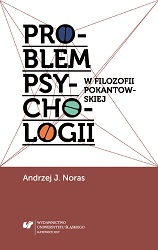
The subject of analyses undertaken in the book are concepts of the post-Kantian philosophers who, in their inquiries, referred to psychology, namely: Jakob Friedrich Fries, Friedrich Eduard Beneke, Johann Friedrich Herbart, Jürgen Bona Meyer, and Leonard Nelson. What is revealed in the course of the author’s investigations is the following. First of all, attempts to establish relationship between psychology and philosophy are not identicalwith the subsequent endeavours to found philosophy on a bedrock of psychology. Such an understanding of relations between the two has come to be known as psychologism, and does not refer to the concepts in question. Second of all, one cannot propose a single model of understanding the relation occurring between philosophy and psychology. As a source of the problem here one can indicate the interpretation of Kant’s thought put forward by Fries. The latter – to a lesser or greater degree – is referred to by the remaining thinkers. Thirdly, the author’s analyses demonstrate such a plethora of standpoints regarding the titular issue that the only common denominator may be broadly understood psychology.
More...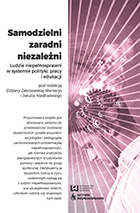
Nieustannie poszukuje się nowych rodzajów oddziaływania rehabilitacyjnego, które mobilizowałyby osoby niepełnosprawne do aktywności, zapewniały partnerską współpracę między osobami niepełnosprawnymi a pełnosprawnymi i ułatwiały przez to proces integracji. Dla powodzenia tych działań niezbędne staje się zaangażowanie instytucji państwowych, organizacji pozarządowych, a także podmiotów działających na zasadach komercyjnych. W niniejszej publikacji chcieliśmy określić, jakie systemowe i strukturalne warunki powinny być spełnione m.in. w sferze pracy, edukacji i szerzej w zakresie polityki społecznej, których rezultatem byłoby stworzenie dogodnych warunków dla realizacji celów i osiągania sukcesów życiowych przez osoby niepełnosprawne. Pragnęliśmy pokazać, jak wielki potencjał może być wykorzystany do szeroko rozumianego przeciwdziałania wykluczeniu i marginalizacji społecznej tej kategorii osób. Publikacja pokazuje, jak wielki potencjał może być wykorzystany do szeroko rozumianego przeciwdziałania wykluczeniu i marginalizacji społecznej osób niepełnosprawnych.
More...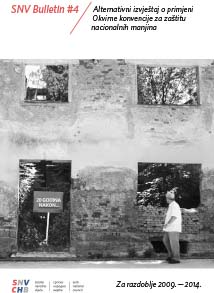
The Serb National Council (SNC), a national coordination of councils of Serb national minority representatives, is an elected political, advisory and coordination entity that operates as a self-government of Serbs in the Republic of Croatia. The SNC is engaged with the protection and promotion of Serbs’ human, civil and ethnic rights, and issues of their identity, participation and integration into Croatian society.The SNC was founded per the Erdut Agreement and the Letter of the Croatian Government about the completion of peaceful reintegration, which guarantees the Serb minority self-government as well as the right to organise as based upon the centuries old tradition of Serb self-government: from church/popular parliaments, to legislative and political acts which regulated the position of Serbs in the 13th and 14th century, to the documents of the National Antifascist Council. It was established in 1997, in Zagreb, at the initiative of the Alliance of Serb Organisations (SKD Prosvjeta, Serb Democratic Forum, Community of Rijeka and Istria Serbs and Joint Council of Municipalities) and among the founders were also the Idependent Democratic Serb Party (SDSS) , Baranja Democratic Forum, Association of refugee and displaced Serbs, representatives of parts of the Serb Orthodox Church (SPC) church municipalities, members of parliament and prominent individuals.
More...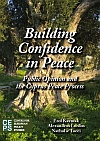
Building Confidence in Peace reports and analyses the results of the firstin a series of public opinion surveys in Cyprus carried out by the Centre for European Policy Studies (CEPS) in collaboration with Greek Cypriot and Turkish Cypriot partners. The project, which began in late 2007, gained momentum and significance with the 21 March 2008 peace process launched by the Greek Cypriot President Demetris Christofias and his Turkish Cypriot counterpart Mehmet Ali Talat.Building Confidence in Peace reports and analyses the results of the first public opinion survey in Cyprus carried out by the Centre for European Policy Studies in collaboration with Greek Cypriot and Turkish Cypriot partners. In the new atmosphere of relaunched negotiations in 2008, this book investigates what Cypriots think of each other, of the peace process and of possible solutions to the conflict. On the basis of our findings, a double need starkly emerges. First, it is essential to act, in parallel with the negotiating process, to raise public confidence in the peace process, in order to ensure that as and when an agreement is reached, the people will go along with it and make its ratification and implementation a success. Second, precisely because of persistent areas of divergence, a set of confidence-building measures (CBMs) should be envisaged to help narrow the gaps separating the two communities. This does not entail shifting attention from negotiations to CBMs. On the contrary, unilateral CBMs or non-controversial measures oriented towards inter-societal reconciliation may have a very positive impact and add momentum to the peace process within a strategic context of renewed negotiations. It is precisely in this spirit that we note the ongoing efforts to build confidence in parallel with the negotiations, first and foremost with the opening of the Ledra Street/Lokmacı gate crossing on 3 April 2008.
More...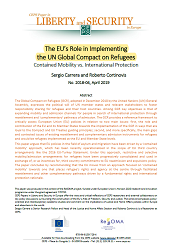
The Global Compact on Refugees (GCR), adopted in December 2018 by the United Nations (UN) General Assembly, expresses the political will of UN member states and relevant stakeholders to foster responsibility sharing for refugees and their host countries. Among GCR key objectives is that ofexpanding mobility and admission channels for people in search of international protection through resettlement and ‘complementary’ pathways of admission. The GCR provides a reference framework to critically assess European Union (EU) policies in relation to two main issues: first, the role and contribution of the EU and its Member States towards the implementation of the GCR in ways that areloyal to the Compact and EU Treaties guiding principles; second, and more specifically, the main gaps and contested issues of existing resettlement and complementary admission instruments for refugeesand would-be refugees implemented at the EU and Member State levels.
More...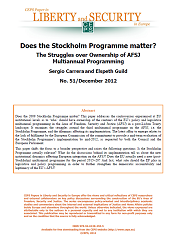
Does the 2009 Stockholm Programme matter? This paper addresses the controversies experienced at EU institutional levels as to ‘who’ should have ownership of the contours of the EU’s policy and legislative multiannual programming in the Area of Freedom, Security and Justice (AFSJ) in a post-Lisbon Treaty landscape. It examines the struggles around the third multiannual programme on the AFSJ, i.e. the Stockholm Programme, and the dilemmas affecting its implementation. The latest affair to emerge relates to the lack of fulfilment by the European Commission of the commitment to provide a mid-term evaluation of the Stockholm Programme’s implementation by mid-2012, as requested by both the Council and the European Parliament.
More...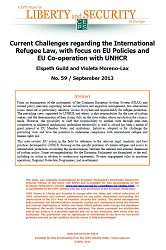
From an examination of the instruments of the Common European Asylum System (CEAS) and related policy measures regarding border surveillance and migration management, two inter-related issues stand out as particularly sensitive: Access to asylum and responsibility for refugee protection.The prevailing view, supported by UNHCR and others, is that responsibility for the care of asylum seekers and the determination of their claims falls on the state within whose jurisdiction the claim is made. However, the possibility to shift that responsibility to another state through inter-state cooperation or unilateral mechanisms undertaken territorially as well as abroad has been a matter of great interest to EU Member States and institutions. Initiatives adopted so far challenge the prevailing view and have the potential to undermine compliance with international refugee and human rights law.
More...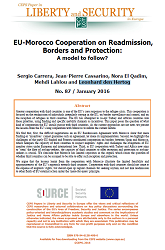
Greater cooperation with third countries is one of the EU’s core responses to the refugee crisis. This cooperation is focused on the read mission of individuals irregularly staying in the EU, on border surveillance and control, and on the reception of refugees in third countries. The EU has attempted to co-opt Turkey and African countries into these priorities, using funding and specific mobility channels as incentives. This paper poses the question of what kind of cooperation the EU should pursue with third countries. As the current approaches are not new, we present the lessons from the EU’s long cooperation with Morocco to inform the current debate. We find that, first, the difficult negotiations on an EU Readmission Agreement with Morocco show that more funding or ‘incentives’ cannot guarantee such an agreement, let alone its implementation. Second, we highlight the challenges of the partly EU-funded and Frontex-coordinated cooperation on borders between Spain and Morocco, which hampers the capacity of third countries to respect migrants’ rights and challenges the obligations of EU member states under European and international law. Third, as EU cooperation with Turkey and Africa now aims to ‘stem’ the flow of asylum-seekers, the capacity of third countries to offer reception and protection to asylum-seekers is crucial. We conclude that Morocco has limited capacities in this regard, which raises the question of whether third countries can be assumed to be able to offer such reception and protection.
More...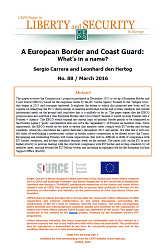
This paper assesses the Commission’s proposal presented in December 2015 to set up a European Border and Coast Guard (EBCG), based on the responses made by the EU border agency Frontex to the ‘refugee crisis’ that began in 2015 and continues unabated. It explores the extent to which this proposed new body will be capable of remedying the EU’s short comings in meeting established border and asylum standards and related institutional needs on the ground and concludes that it is unlikely to do so. The paper argues that the EBCG proposal does not establish a true European Border and Coast Guard. Instead it would revamp Frontex into a Frontex + Agency. The EBCG would expand the current logic of national border guards to be committed to the Frontex Agency ‘pools’ and therefore does not solve the ‘dependency’ of Frontex on member states. More importantly, the EBCG would do too little to ensure that member states comply with EU border and asylum standards, which has constituted the central deficiency throughout 2015 and earlier.
More...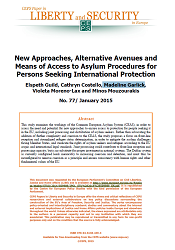
This study examines the workings of the Common European Asylum System (CEAS), in order to assess the need and potential for new approaches to ensure access to protection for people seeking itin the EU, including joint processing and distribution of asylum seekers. Rather than advocating the addition of further complexity and coercion to the CEAS, the study proposes a focus on front-line reception and streamlined refugee status determination, in order to mitigate the asylum challenges facing Member States, and vindicate the rights of asylum seekers and refugees according to the EU acquis and international legal standards. Joint processing could contribute to front-line reception and processing capacity, but is no substitute for proper investment in national systems.
More...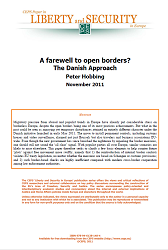
Migratory pressure from abroad and populist trends in Europe have already put considerable stress on borderless Europe, despite the open borders being one of its most precious achievements. But what in the past could be seen as annoying yet temporary disturbances attained an entirely different character under the Danish initiative launched in early May 2011. The move to install permanent controls, including customs houses and video surveillance, alarmed not just Brussels but also travelers and business associations EU wide. Even though the new government has since banished the nightmare by repealing the border measures, one should still not sound the ‘all clear’ signal. With populist parties all over Europe, similar scenarios are likely to arise elsewhere.
More...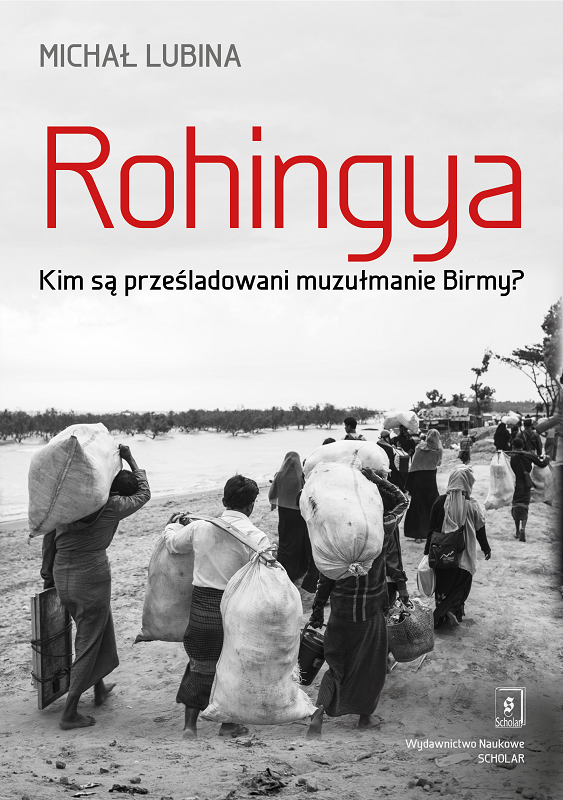
Otrzymaliśmy bardzo potrzebną monografię o Rohingya – jednej z najbardziej prześladowanych i umęczonych społeczności na świecie, milionie ludzi bez domów i ziemi, których żaden kraj nie chce przyjąć. Jest to równocześnie uniwersalna opowieść o dwóch „izmach” – kolonializmie i nacjonalizmie – które doprowadziły do obecnej tragedii. Powstawanie granic i narodziny narodów są niezwykle fascynujące, ale bywają też bolesne, pełne nienawiści i przemocy. I świadomość tego jest nam dziś bardzo potrzebna. Nie tylko w Azji.Agnieszka Lichnerowicz Kim są Rohingya? Na to wydawałoby się banalne pytanie nie ma prostej odpowiedzi. W tle jest tragedia miliona ludzi, o których przeszłości świat prawie nic nie wie. Ba, których nazwy nie jesteśmy w stanie dobrze wymówić. O fenomenie „narodu wygnanego” Rohingya pisze w prezentowanej monografii naukowej Michał Lubina, a jest to pierwsze tego typu przedsięwzięcie wydawnicze w Polsce. Autor jak mało kto w Polsce zna Birmę i to od podszewki. Naukowy styl potrafi okrasić anegdotą. Nie boi się stawiać odważnych tez niejako „pod włos” utartym interpretacjom. Otrzymana książka to lektura obowiązkowa dla tych wszystkich, którzy chcą wyjść poza nagłówki gazet i zrozumieć mechanizm jednego z większych exodusów współczesnego świata.Jacek Pawlicki, „Newsweek Polska”W 2017 roku armia birmańska doprowadziła do ucieczki z Birmy ponad 700 tys. muzułmanów Rohingya. W jednej z największych katastrof humanitarnych ostatnich lat doszło do czystki etnicznej, zbrodni przeciw ludzkości, a może nawet do ludobójstwa. Kim są Rohingya, dlaczego wzbudzają taką nienawiść i czemu stali się kolektywnym kozłem ofiarnym? W prezentowanej książce znajdziemy odpowiedzi – pozornie proste, a w istocie niesamowicie złożone – na te i wiele innych zasadniczych pytań związanych z Rohingya. Członkowie tej społeczności są muzułmanami i są prześladowani – to właściwie jedyne dwa fakty niepodlegające dyskusji. Reszta jest przedmiotem zażartych sporów, a ich wynik decyduje o losie ponadmilionowej wspólnoty. Książkę wzbogacają poruszające zdjęcia autorstwa Marcina Zaborowskiego. Ukazują one ludzki wymiar tragedii Rohingya i są ważnym świadectwem dopełniającym chłodną analizę naukową przedstawioną w wywodzie pracy. Dr Michał Lubina – adiunkt w Instytucie Bliskiego i Dalekiego Wschodu na Wydziale Studiów Międzynarodowych i Politycznych Uniwersytetu Jagiellońskiego. Autor kilku książek dotyczących Birmy, w tym m.in. Birma (Warszawa 2014), Pani Birmy Aung San Suu Kyi. Biografia polityczna (Warszawa 2015), a także The Moral Democracy. The Political Thought of Aung San Suu Kyi (Warszawa 2019).Patronat medialny: Radio TOK FM
More...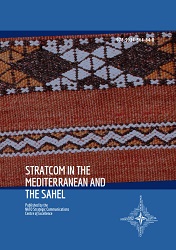
Seas and deserts are uniting and dividing elements of human life on this planet. The Mediterranean region, North Africa, and the Sahel have witnessed a long history of historical cycles of cooperation and conflict. Since the Arab Spring and the fall of Qaddafi in Libya in 2011, the region has received increasing international attention given the combination of violent conflict and unprecedented migration flows at Europe’s doorstep. This paper aims to analyse the scope and nature of the impact of security challenges in this region upon strategic communications, mainly for NATO and its member states. This study is based on the analysis of global and regional open sources regarding four key issues: terrorism, migration, illicit trafficking, and great power competition. These have been identified as macro areas that affect the entire region and are deeply influenced by information. The conclusions provide succinct recommendations on how to conduct an informed and successful STRATCOM campaign in the region.
More...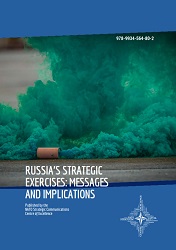
In this report, several of Russia’s strategic military exercises come under the spotlight to explore the messages and implications of these activities. A nation’s military exercises, especially strategic, are a form of important communication to a wide array of audiences including adversaries, allies, partners and the nation’s own population. This type of communication provides a better understanding of the scope and scale of a country’s military capabilities and readiness. It also provides valuable insights into a nation’s interests, operational art and strategic thinking. Military exercises support political, military and geopolitical intents as well as demonstrating capabilities and challenging our ways of thinking beyond the current framework of traditional military ‘modus operandi’.
More...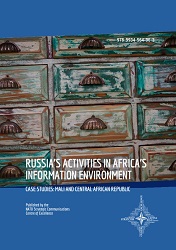
This paper focuses on Russia’s strategies in Africa. The first ever Russia-Africa summit, co-hosted in October 2019 by Russian President Vladimir Putin and Egyptian President Abdel Fattah Al-Sisi in Sochi, was presented by both Russian and international media as a milestone in Russia’s return to the African continent. Leaders and delegations of the vast majority of African states met with Russian President Vladimir Putin, Foreign Minister Sergey Lavrov, and other Russian representatives to discuss possible projects of cooperation between their respective countries. The summit ranked among the largest of recent Africa-partner summits (EU-Africa, China-Africa, US-Africa, and Japan-Africa). For example, Russia was able to welcome more state delegations than the US at their summit. The declared initiatives of cooperation appeared impressive, ranging from nuclear energy, oil and gas, to automobile production and financial loans for various fields. This meeting sparked numerous claims by both Western and Russian media that Russia is a key player in the region. There are plans for organizing another summit in 2022.
More...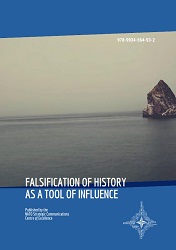
This study deals with the growing trend of Russia’s use of historical propaganda to further its foreign policy goals. It contains chapters written by experts in the field in the respective countries of Estonia, Finland, Latvia and Poland. The methodological aspects of the project were discussed in detail during a seminar in Riga on 11 December 2018. It was agreed that, for the integrity of the compendium, at least the central theme should be commonly understood as Jowett and O’Donnell conceptualise it: propaganda is a deliberate and systematic attempt to shape perceptions, manipulate cognitions, and direct behaviour to achieve a response that furthers the desired intent of the propagandist. Its systematic nature requires the longitudinal study of its progress. Because the essence of propaganda is its deliberateness of purpose, considerable investigation is required to find out what this purpose is.
More...